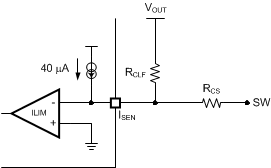SNVS276I April 2004 – February 2019 LM2743
PRODUCTION DATA.
- 1 Features
- 2 Applications
- 3 Description
- 4 Revision History
- 5 Pin Configuration and Functions
- 6 Specifications
- 7 Detailed Description
- 8 Application and Implementation
- 9 Power Supply Recommendations
- 10Layout
- 11Device and Documentation Support
- 12Mechanical, Packaging, and Orderable Information
Package Options
Mechanical Data (Package|Pins)
- PW|14
Thermal pad, mechanical data (Package|Pins)
Orderable Information
7.3.11 Foldback Current Limit
In the case where extra protection is used to help an output short condition, a current foldback resistor (RCLF) should be considered, see Figure 29. First select the percentage of current limit foldback (PLIM):
Equation 12. PLIM = ILIM x P
where P is a ratio between 0 and 1.
 Figure 29. Foldback Current Limit Circuit
Figure 29. Foldback Current Limit Circuit Obtain the RCS with the following equation:
Equation 13. 

where ISEN = 40 μA. If the switch node goes above 9.5 V the following criterion must be satisfied:
Equation 14. 

The equation for calculating the foldback resistance value is:
Equation 15. 
